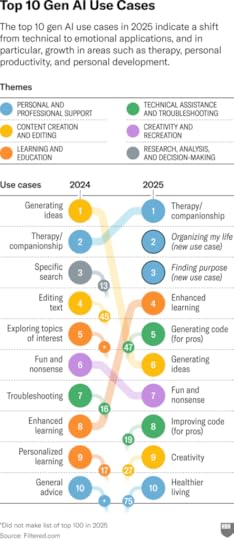The Rise of Synthetic Intimacy: AI is Becoming Your Co-Pilot in Real Life

How do you use generative AI?
Is it to create content, collaborate on work, ideate, learn, code, or seek direction?
What if I told you that, according to one research study, the number one application for generative AI is to help with mental health and loneliness?
According to one study, people are increasingly turning to AI for emotional support, personal growth, and self-improvement.
This is the 2nd year in a row when Marc Zao-Sanders publishes his research in Harvard Business Review, that explores “How People are Really Using Gen AI.”
As a digital anthropologist, it’s fascinating. As a digital analyst, I have many questions, especially around the subjective methodology and scope. I wouldn’t view these results as scientific nor do I agree with their accuracy. But let’s set that aside for now and have fun with the findings at a human level.

According to this research effort, we see top use cases shifting from curiosity, collaboration, and productivity to something more personal and growth oriented, with the top three including therapy/companionship, organizing my life, and finding purpose. The latter two represent new uses in 2025.
The number one use case is both surprising and not surprising, “therapy/companionship.” It’s surprising to see humans use artificial intelligence to virtualize treatment and healing. It’s not surprising though that people find it more approachable to embrace synthetic intimacy. Years ago, for example, I studied the willingness of men to open-up to AI for therapy and adults in general to seek medical advice from AI. In both cases, the sentiment was similar. It was not only easier to speak candidly and openly to a machine, it was cathartic and beneficial. People could be honest with AI versus another human being, without the fear of being judged.
The same could be true for organizing my life and finding purpose. When people recognize the opportunity to change or improve, it’s easy to put it off or ultimately deny that anything urgent or ultimately needed at all. But with AI, people can express themselves freely, from the comfort of anywhere, to receive nonjudgmental advice and insights.
To see enhanced learning jump from number 8 in 2024 to number 4 in 2025 is also testament to people recognizing AI as a companion for self-improvement and personal and professional development. And with creativity jumping from number 27 to number 9 and healthier living climbing from 75 to 10, 80% of the top 10 gen AI use cases are aimed at personal and professional development (I’m aggregating four classifications as they reflect behavior that would overlap on a VENN diagram instead of representing four separate behaviors/intentions/aspirations. For example, Creativity is categorized as “content creation and editing” and “fun and nonsense” is classified as “creativity and recreation.”
A New Chapter in Human + Machine AugmentationIn these high-level findings, several profound patterns emerge, with each pointing to a fundamental Mindshift in how humans and machines are co‑evolving (A mindshift = fundamentally changing how we perceive and interact with the world and how we take different actions as a result. Embracing new perspectives enables us to adapt, innovate, and lead effectively in times of change!)

We are witnessing a Mindshift in how people interact with AI.
The diverse applications of generative AI across both personal and professional domains illustrate how individuals are integrating this technology into their daily lives. This aligns with what I call the “Novel Economy,” where traditional rules no longer apply, and new opportunities emerge that require innovative thinking and adaptability .
In my research, I documented the emergence of “Generation Novel” (Gen N), a cross-generational cohort shaped by disruptive technologies, digital experiences, and global events. The widespread adoption of generative AI tools, as highlighted in the article, exemplifies how Gen N is leveraging technology to redefine work, creativity, and personal growth.
This initial research provides evidence of a broader cultural transformation, where technology serves as a catalyst for reimagining human potential and societal norms. This is a time for a Mindshift, one where open-mindedness, curiosity, and creativity fuel the continued exploration of how AI can be harnessed, where it works for us, not the other way around, to foster creativity, enhance productivity, and drive meaningful change.
Continue reading…
Mindshift: Transform Leadership, Drive Innovation, Reshape the Future
Lifescale: How to Live a More Creative,Productive, and Happy Life
The post The Rise of Synthetic Intimacy: AI is Becoming Your Co-Pilot in Real Life appeared first on Brian Solis.



